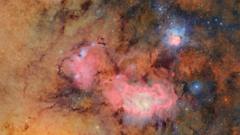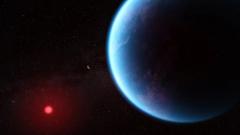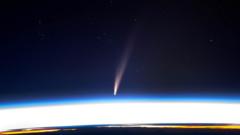A series of independent studies have dismissed earlier indications of life on the exoplanet K2-18b, revealing the complexities of distant planetary observation and clarifying the challenges of confirming extraterrestrial existence.
New Analyses Nullify Life Claims on K2-18b Exoplanet

New Analyses Nullify Life Claims on K2-18b Exoplanet
After initial excitement over potential signs of life on K2-18b, recent studies unanimously conclude the evidence is unconvincing.
In April, astronomers sent waves of excitement through the scientific community with reports of a potential signature of life on K2-18b, an exoplanet situated over 120 light-years from Earth. However, this excitement quickly turned to skepticism as three different analyses conducted by independent teams questioned the findings. Notably, these investigations found no substantial evidence supporting claims of biological processes occurring on the distant planet.
“The evidence simply evaporates,” stated Luis Welbanks, an astronomer at Arizona State University and a co-author of one of the critical studies, asserting the lack of conclusive proof for the existence of extraterrestrial life.
The ongoing debate highlights a significant hurdle in modern astronomy: the complexities associated with observing remote exoplanets. While planets like Jupiter are easily observed due to their reflective surfaces, distant planets such as K2-18b become undetectable with the naked eye or standard telescopic equipment.
To study these far-off worlds, astronomers have developed numerous innovative techniques. One method involves measuring the wobble of stars caused by the gravitational influence of orbiting planets. More recently, in 2010, astronomers managed to investigate a planet known as GJ 1214b located 48 light-years away by observing its transits across its star, demonstrating a possible water-rich atmosphere through the light filtering process.
The advent of the James Webb Space Telescope in 2022 marked a significant breakthrough in the observation of exoplanets. By detecting subtle variations in starlight, this technology has allowed scientists to glean detailed information about the atmospheric make-up of distant worlds.
As the investigation into K2-18b continues, the scientific community remains committed to unraveling the mysteries that lie beyond our solar system, emphasizing the importance of rigorous analysis in the search for extraterrestrial life.
“The evidence simply evaporates,” stated Luis Welbanks, an astronomer at Arizona State University and a co-author of one of the critical studies, asserting the lack of conclusive proof for the existence of extraterrestrial life.
The ongoing debate highlights a significant hurdle in modern astronomy: the complexities associated with observing remote exoplanets. While planets like Jupiter are easily observed due to their reflective surfaces, distant planets such as K2-18b become undetectable with the naked eye or standard telescopic equipment.
To study these far-off worlds, astronomers have developed numerous innovative techniques. One method involves measuring the wobble of stars caused by the gravitational influence of orbiting planets. More recently, in 2010, astronomers managed to investigate a planet known as GJ 1214b located 48 light-years away by observing its transits across its star, demonstrating a possible water-rich atmosphere through the light filtering process.
The advent of the James Webb Space Telescope in 2022 marked a significant breakthrough in the observation of exoplanets. By detecting subtle variations in starlight, this technology has allowed scientists to glean detailed information about the atmospheric make-up of distant worlds.
As the investigation into K2-18b continues, the scientific community remains committed to unraveling the mysteries that lie beyond our solar system, emphasizing the importance of rigorous analysis in the search for extraterrestrial life.






















